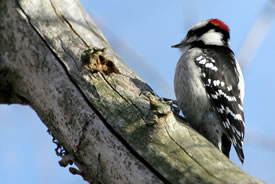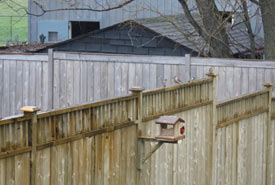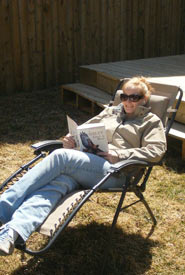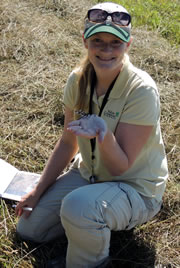#HowToNature series: How to bird (Part Two)

Downy woodpecker (Photo by Bill Hubick)
In Part One of the birding how-to, I talked about the joy of "birding" (also known as birdwatching), what one should bring and what to watch or listen for. With that knowledge at hand, the next question is: "Where to go?"
Where to go birding
Now that you have your ears piqued, eyes open wide and bins strapped on (optional), pick a favourite park, natural area or hiking trail and get out there! In Ontario, some of the Nature Conservancy of Canada’s (NCC’s) birding hotspots include the Minesing Wetlands in mid-late April for migrating waterfowl, the Western Lake Erie Islands (specifically Pelee Island) in early May for migrating songbirds, and Carden Alvar in late May for grassland birds.

My backyard cardinal (Photo by Kristyn Ferguson/NCC staff)
For those looking to bird closer to home, try setting up a bird feeder or two on your property and perch yourself in a comfortable seat to watch the variety of species that will appear. Sunflower seeds are a favourite to attract a variety of species all year round.
In the spring and summer months, a simple and affordable hummingbird feeder can be hung and filled with a syrup solution to attract gorgeous ruby-throated hummingbirds.
Here's how:
- Boil four parts water.
- Add one part sugar.
- Let cool, fill and enjoy!
In the winter, a suet block will attract woodpeckers, nuthatches and more. I keep a backyard species list and am already up to 30 only halfway through the year, which isn’t bad for my little suburban backyard. Of course that might be because I have five feeders on the go! I say there’s no such thing as going overboard (though my husband might disagree).
Tips

Nerding out in the backyard - note field guide and earbuds (Photo by Jeff Verberne)

Nerding out in the backyard - note field guide and earbuds (Photo by Jeff Verberne)
- For beginners, be sure to go easy on yourselves and take your learning one bird at a time. There are literally hundreds of birds making use of our Canadian wilderness, so start small.
- Mornings are best, but birds are typically active throughout the day.
- Make a list of what you do recognize (perhaps the vibrant red of a northern cardinal, the blue-black of an American crow, the orange-red belly of an American robin hopping about in spring).
- For those you don’t recognize, note the field marks: "white eye ring!" "pink legs!" "black bill!" Write them down so you can look them up later and find what species matches all of those features.
- Make bird call CDs/mp3s, and bird field guides part of your casual listening and reading collection. Waterfowl such as ducks and geese can be a great place to start because they tend to swim lazily by, giving you lots of time to look closely at them. I saw my first hooded merganser and bufflehead this year and have so say I didn’t know ducks could be so stunning!
- Follow bird groups' Facebook pages for a constant news feed delight of beautiful and unusual bird photos.
- You can bird-watch year-round. May and June are excellent times to listen to birdsong as a plenitude of birds pass through southern Canada on their way north to their summer breeding grounds. Winter can actually be an awesome time to get started, with Christmas Bird Counts happening every year in December and January. Winter brings easy-to-recognize species like black-capped chickadee and blue jay, which stand out against the stark white background.
If you can find a mentor birder to teach you some tips and tricks for identifying birds, you'll find your learning will likely be vastly accelerated. However, I started out on my own with my Sibley's Guide to Birds, "Watching Warblers" DVD and trusty Cornell Lab of Ornithology website, and have managed pretty well so far! I can’t wait for my next birding adventure to see what I find, and hope I’ll see you out there too!


